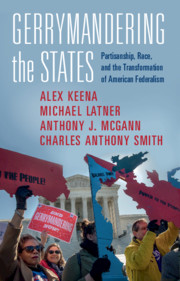32 results
9 - How to Design Effective Anti-gerrymandering Reforms
-
- Book:
- Gerrymandering the States
- Published online:
- 02 July 2021
- Print publication:
- 22 July 2021, pp 163-184
-
- Chapter
- Export citation
Conclusion
-
- Book:
- Gerrymandering the States
- Published online:
- 02 July 2021
- Print publication:
- 22 July 2021, pp 185-190
-
- Chapter
- Export citation
2 - What Happened in 2011? The Other “Great Gerrymander”
-
- Book:
- Gerrymandering the States
- Published online:
- 02 July 2021
- Print publication:
- 22 July 2021, pp 14-49
-
- Chapter
- Export citation
5 - Racial Geography, the Voting Rights Act, and Bias
-
- Book:
- Gerrymandering the States
- Published online:
- 02 July 2021
- Print publication:
- 22 July 2021, pp 96-116
-
- Chapter
- Export citation
Contents
-
- Book:
- Gerrymandering the States
- Published online:
- 02 July 2021
- Print publication:
- 22 July 2021, pp v-viii
-
- Chapter
- Export citation
6 - The Policy and Social Consequences of State Legislative Gerrymandering
-
- Book:
- Gerrymandering the States
- Published online:
- 02 July 2021
- Print publication:
- 22 July 2021, pp 117-134
-
- Chapter
- Export citation
Tables
-
- Book:
- Gerrymandering the States
- Published online:
- 02 July 2021
- Print publication:
- 22 July 2021, pp xi-xii
-
- Chapter
- Export citation
Index
-
- Book:
- Gerrymandering the States
- Published online:
- 02 July 2021
- Print publication:
- 22 July 2021, pp 227-230
-
- Chapter
- Export citation
References
-
- Book:
- Gerrymandering the States
- Published online:
- 02 July 2021
- Print publication:
- 22 July 2021, pp 209-226
-
- Chapter
- Export citation
3 - When Politicians Draw the Maps
-
- Book:
- Gerrymandering the States
- Published online:
- 02 July 2021
- Print publication:
- 22 July 2021, pp 50-78
-
- Chapter
- Export citation
4 - How Political Geography Affects Bias
-
- Book:
- Gerrymandering the States
- Published online:
- 02 July 2021
- Print publication:
- 22 July 2021, pp 79-95
-
- Chapter
- Export citation
Appendix - Appendices
-
- Book:
- Gerrymandering the States
- Published online:
- 02 July 2021
- Print publication:
- 22 July 2021, pp 191-208
-
- Chapter
- Export citation
Copyright page
-
- Book:
- Gerrymandering the States
- Published online:
- 02 July 2021
- Print publication:
- 22 July 2021, pp iv-iv
-
- Chapter
- Export citation
Acknowledgments
-
- Book:
- Gerrymandering the States
- Published online:
- 02 July 2021
- Print publication:
- 22 July 2021, pp xiii-xiv
-
- Chapter
- Export citation
1 - Redistricting Wars in the US States
-
- Book:
- Gerrymandering the States
- Published online:
- 02 July 2021
- Print publication:
- 22 July 2021, pp 1-13
-
- Chapter
- Export citation
7 - The Democratic Harms of Gerrymandering
-
- Book:
- Gerrymandering the States
- Published online:
- 02 July 2021
- Print publication:
- 22 July 2021, pp 135-147
-
- Chapter
- Export citation
Figures
-
- Book:
- Gerrymandering the States
- Published online:
- 02 July 2021
- Print publication:
- 22 July 2021, pp ix-x
-
- Chapter
- Export citation
8 - When the Courts Redistrict
-
- Book:
- Gerrymandering the States
- Published online:
- 02 July 2021
- Print publication:
- 22 July 2021, pp 148-162
-
- Chapter
- Export citation

Gerrymandering the States
- Partisanship, Race, and the Transformation of American Federalism
-
- Published online:
- 02 July 2021
- Print publication:
- 22 July 2021
Bibliography
-
- Book:
- Gerrymandering in America
- Published online:
- 05 March 2016
- Print publication:
- 04 April 2016, pp 237-246
-
- Chapter
- Export citation



